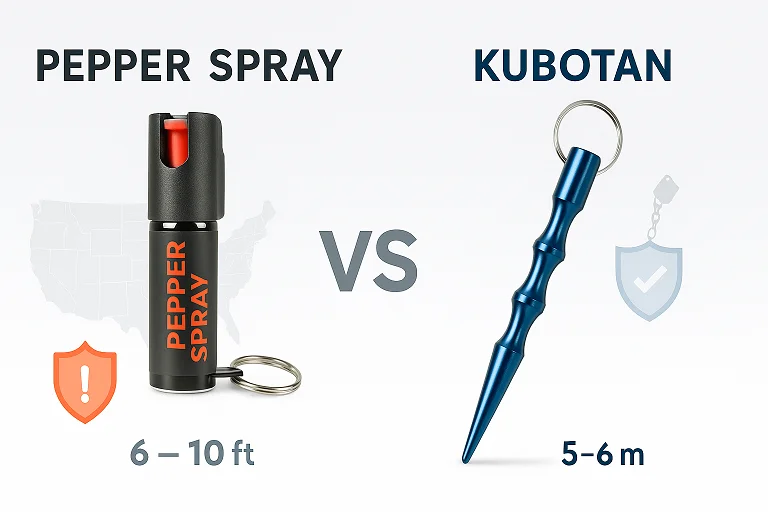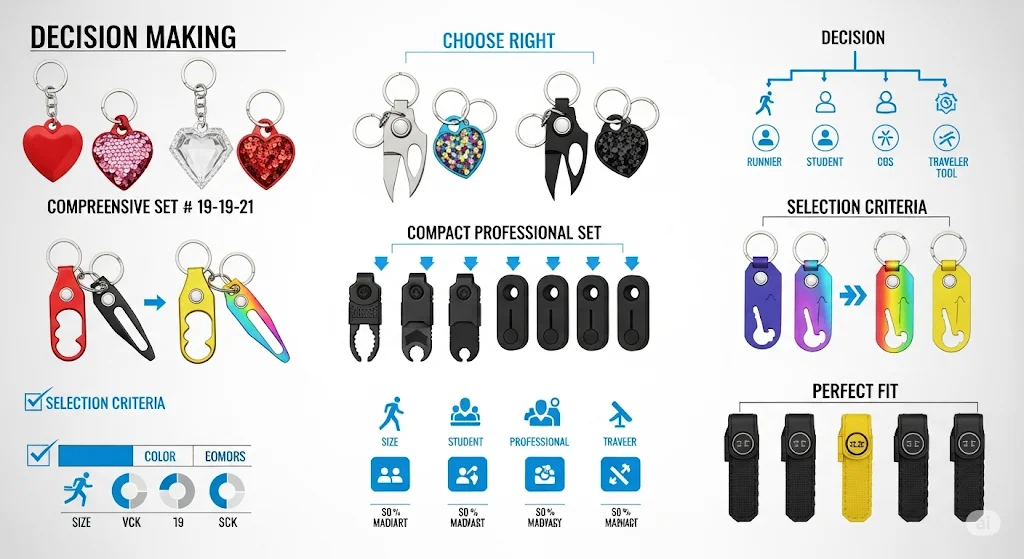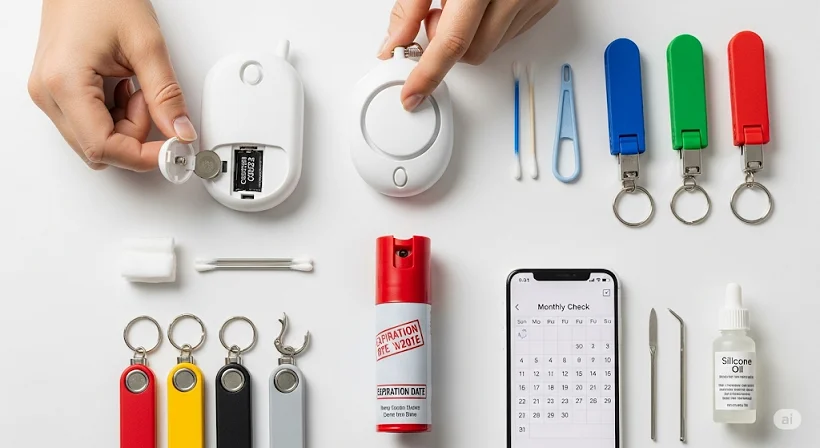Pepper Spray vs. Kubotan—Which Tool Fits Your Lifestyle?
Side-by-side comparison of stopping power, legality and ease-of-carry for two top self-defense gadgets. Expert analysis to help you choose the right tool.

Pepper Spray vs. Kubotan—Which Tool Fits Your Lifestyle?
Personal safety is a priority for many, and choosing the right self-defense tool can make a significant difference in feeling secure. Two popular options that often create confusion are pepper spray and the kubotan. Both are effective self-defense tools, but their approaches to personal protection are fundamentally different.
This comprehensive comparison will help you understand the stopping power, legality, and practical considerations of each tool, so you can make an informed decision that fits your lifestyle and comfort level.
Always check your local and state laws before carrying any self-defense tool. Laws vary significantly by jurisdiction. For comprehensive legal information, read our [Complete Guide to Self-Defense Laws in the US](/blog/self-defense-laws-us).What Are Pepper Spray and Kubotan?
Pepper Spray: Chemical Self-Defense
Pepper spray (oleoresin capsicum or OC) is a chemical irritant derived from hot chili peppers. When deployed, it causes:
- Intense burning sensation in eyes, nose, and skin
- Temporary blindness lasting 15-45 minutes
- Respiratory irritation causing coughing and difficulty breathing
- Disorientation that allows time to escape
Available in keychain canisters, pocket-sized units, and various formulations, pepper spray is designed to incapacitate from a distance.
Kubotan: Pressure Point Control Tool
A kubotan is a small, cylindrical striking tool typically 5-6 inches long, made of metal, plastic, or hardened polymer. Developed by Takayuki Kubota in the 1970s for law enforcement, it's used for:
- Pressure point control on nerve locations
- Pain compliance through targeted strikes
- Breaking attacker's grip on wrists or arms
- Close-quarters defense in confined spaces
The kubotan serves as a force multiplier that enhances the effectiveness of strikes to vulnerable areas.
Detailed Comparison: Pepper Spray vs. Kubotan
1. Stopping Power and Effectiveness
| Aspect | Pepper Spray | Kubotan |
|---|---|---|
| Effective Range | 6-12 feet ballistic stream | Arm's length contact only |
| Incapacitation Time | 15-45 minutes temporary disability | Immediate pain, variable duration |
| Success Rate | 86% compliance in law enforcement studies | Depends heavily on user training |
| Against Multiple Attackers | Can spray multiple targets | Single attacker engagement |
Pepper Spray Advantages:
- Distance protection: Maintain 6-12 feet from attacker
- Chemical incapacitation: Works regardless of attacker's pain tolerance
- Area effect: Wide spray pattern can affect multiple threats
- Animal defense: Effective against aggressive dogs and wildlife
Pepper Spray Limitations:
- Wind interference: Can blow back toward user
- Indoor risks: May affect bystanders in enclosed spaces
- Protective gear: Less effective against attackers wearing glasses/masks
- Expiration dates: Canisters lose effectiveness over 2-4 years
Kubotan Advantages:
- No expiration: Never loses effectiveness
- Weather independent: Works in all conditions
- Precise targeting: Focused strikes to pressure points
- Control techniques: Can be used for joint manipulation
Kubotan Limitations:
- Training required: Effectiveness depends on proper technique
- Close contact: Must engage attacker at arm's length
- Strength dependent: Some techniques require physical force
- Limited against larger attackers: May be insufficient against determined assailants
2. Legal Considerations by State
Pepper Spray Legality
Legal in all 50 states with varying restrictions:
| State | Restrictions |
|---|---|
| California | Maximum 2.5 oz canisters |
| New York | Age 18+, licensed dealers only |
| Massachusetts | Requires firearms ID or license |
| Florida | Maximum 2 oz canisters |
| New Jersey | Maximum 0.75 oz, age restrictions |
| Wisconsin | No restrictions for adults |
| Texas | No size or age restrictions |
Kubotan Legality
Generally legal nationwide with these considerations:
- TSA restrictions: Prohibited in carry-on luggage, allowed in checked bags
- School zones: May be prohibited on educational property
- Government buildings: Often restricted in courthouses, federal buildings
- Intent matters: Could be classified as weapon if used with criminal intent
3. Ease of Carry and Accessibility
Portability Comparison
| Feature | Pepper Spray | Kubotan |
|---|---|---|
| Weight | 28-60 grams | 40-80 grams |
| Size | Keychain to 4-inch canister | 5-6 inch stick |
| Attachment | Keychain, belt clip, purse | Keychain, pocket carry |
| Concealment | Obvious spray canister | Looks like keychain tool |
| Quick Access | Safety cap may slow deployment | Instantly ready |
Daily Carry Considerations
Pepper Spray Carry Tips:
- Choose keychain models for convenience
- Practice one-handed deployment
- Keep safety cap easily removable
- Store upright to prevent settling
Kubotan Carry Tips:
- Attach securely to keychain
- Practice proper grip techniques
- Ensure comfortable pocket carry
- Consider quick-release options
Which Tool Fits Your Lifestyle?
Choose Pepper Spray If:
✅ You prefer distance defense - Keep attackers 6-12 feet away
✅ Minimal training desired - Point and spray technique
✅ Multiple threat scenarios - Can engage several attackers
✅ Animal encounters possible - Effective against aggressive dogs
✅ Quick incapacitation needed - Immediate chemical effects
Best for: Joggers, college students, urban commuters, outdoor enthusiasts
Choose Kubotan If:
✅ Close-quarters comfort - Willing to engage at arm's length
✅ Training commitment - Ready to learn proper techniques
✅ Reliability priority - Tool that never expires or fails
✅ Discrete carry - Doesn't look like obvious weapon
✅ Precision control - Ability to use measured force
Best for: Security professionals, martial artists, frequent travelers, those with pepper spray restrictions
The Hybrid Approach: Why Not Both?
Many personal safety experts recommend a layered defense system:
- Personal alarm - First line of defense to attract attention
- Pepper spray - Medium-range chemical deterrent
- Kubotan - Close-quarters backup option
Our Rose Red Sequin Dinner Bag 19 PCS Self Defense Keychain Set includes both pepper spray and kubotan components, giving you options for any situation.
Practical Training and Usage Tips
Pepper Spray Best Practices
Deployment Technique:
- Remove safety cap quickly
- Aim for eyes and nose at center mass
- Spray in side-to-side pattern for 2-3 seconds
- Move to safety immediately after spraying
- Call for help once at safe distance
Training Recommendations:
- Practice with inert training sprays
- Learn wind assessment techniques
- Drill one-handed deployment
- Understand spray patterns and range
Kubotan Training Essentials
Target Areas:
- Neck pressure points - Carotid artery area
- Wrist control - Radial nerve pressure
- Rib strikes - Intercostal nerve areas
- Shin/foot impacts - Bone contact points
Grip Techniques:
- Ice pick grip - Striking downward
- Hammer grip - Horizontal strikes
- Reinforced grip - Two-handed control
Training Resources:
- Local martial arts schools
- Self-defense workshops
- Online video tutorials
- Law enforcement training programs
Cost Analysis and Maintenance
Initial Investment
| Item Type | Price Range | Replacement Frequency |
|---|---|---|
| Quality Pepper Spray | $8-25 | Every 2-4 years |
| Professional Kubotan | $12-40 | One-time purchase |
| Combination Set | $25-60 | Mixed schedule |
Long-term Costs
Pepper Spray:
- Regular replacement needed
- Practice canisters for training
- Potential clothing/gear replacement if accidentally discharged
Kubotan:
- One-time investment
- Optional training costs
- No maintenance required
Product Recommendations
Based on our analysis, here are top-rated options for different needs:
For Versatile Protection: Classic Black Self Defense Keychain Set includes both pepper spray and kubotan tools in a professional package.
For Outdoor Enthusiasts: Army Green Self Defense Keychain Set features weather-resistant components and high-visibility colors.
For Students: Cute Bow 12 PCS Self Defense Keychain Kit offers comprehensive protection in a discreet, campus-appropriate design.
Common Myths Debunked
Pepper Spray Myths
❌ "Pepper spray always works instantly"
✅ Reality: Effects can take 5-30 seconds to fully manifest
❌ "Wind always makes pepper spray useless"
✅ Reality: Proper technique and gel formulations reduce wind risks
❌ "Pepper spray is illegal in most places"
✅ Reality: Legal in all 50 states with varying restrictions
Kubotan Myths
❌ "Kubotans are deadly weapons"
✅ Reality: Designed for pain compliance, not lethal force
❌ "Anyone can use a kubotan effectively"
✅ Reality: Requires proper training for maximum effectiveness
❌ "Kubotans are banned everywhere"
✅ Reality: Legal in most jurisdictions with few restrictions
Final Recommendations
The choice between pepper spray and kubotan ultimately depends on your personal factors:
Choose pepper spray if you prioritize ease of use, distance protection, and minimal training requirements.
Choose kubotan if you value reliability, precision control, and are committed to proper training.
Choose both if you want comprehensive protection options for different scenarios.
Remember: The best self-defense tool is the one you carry consistently, know how to use properly, and are mentally prepared to deploy when necessary.
Internal Resources
For more comprehensive safety information, explore these related guides:
- Complete Guide to Self-Defense Laws in the US - Essential legal information
- College Safety Tips for Women - Campus-specific protection strategies
- How to Use Personal Safety Alarms - Audio deterrent techniques
Stay informed, stay prepared, and most importantly - stay safe.
Additional Resources
- National Institute of Justice: Research on OC effectiveness
- International Association of Chiefs of Police: Self-defense guidelines
- Transportation Security Administration: Current carry restrictions
- Local law enforcement agencies: Regional training opportunities
Last updated: January 2025
Related Articles

How to Choose the Right Self-Defense Keychain Set
Match kit size, color & tool mix to your daily routine with our quick decision chart. Expert buying guide for selecting the perfect safety keychain system.

The Ultimate Safety-First Gift Guide for Mother's Day 2025
Surprise mom with stylish self-defense gifts that show you care about her security and confidence. Unique Mother's Day gift ideas beyond flowers and chocolates.

5-Minute Monthly Check-up for Your Safety Keychain
Simple maintenance—battery test, pepper-spray expiry & strap wear—to keep your kit mission-ready. Expert maintenance guide for maximum reliability.